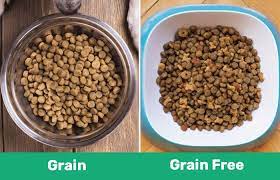Authored by Tractor Supply Company
Dog owners want what is best for their dogs and that starts with a healthy diet filled with quality ingredients. But are the things you are feeding your dog actually beneficial to their health? Understanding the role the ingredients play in your dog’s overall health and what options you should choose—and what you should stay away from—is vital if you want to help your dog live a long and healthy life.
Benefits of grain-free dog food diets
Grain-free dog food is said to lead to a healthier lifestyle for your four-legged friend, but what actually makes it beneficial for your dog’s health?
A grain-free diet that contains all the needed nutrients has been seen to improve your dog’s coat, teeth, and even breath.
Grains that are commonly seen in dog food include:
- Wheat
- Corn
- Barley
- Rye
- Oats
- Soy
- Rice
Some pet owners view grains as filler and are worried about the level of carbohydrates in grain-based dog food. Grain-free dog foods still include carbohydrates like peas, potatoes, and lentils. But these carbohydrates are vital to a dog’s nutrition by giving them the energy to go on walks and play. Dog owners who are switching to grain-free foods should be aware that these grain-free ingredients can actually contain more carbohydrates, which can lead to weight gain in dogs if not monitored.
An important note about grain-free foods is that they are not necessarily gluten-free. There may be other sources of gluten in the food that are not from grains, and there may be cross-contamination during the manufacturing process.
For some dogs, grain-based foods can cause serious illnesses from allergies and intolerances. Symptoms of grain intolerances in dogs include ear and skin infections, diarrhea, and vomiting. If you believe your dog may have a food allergy to grain, please start by asking your veterinarian what symptoms of food allergies and food intolerances to look for in your dog. Together, you can come up with a grain-free diet that will work.
If you are interested in switching to grain-free dog food, what should you look for when choosing one?
Grain-free dog food and dog treats are commonly touted as being a better source of protein, but that isn’t necessarily the case. While it would be great if dog food manufacturers filled the space left by no grains with more protein, you should be sure to look at the ingredients list on your dog food to make sure the ingredients that have been added are ones that give your dogs the nutrients they need and aren’t just filler.
If you are not sure which ingredients are safe for your dog, speak with your veterinarian or a veterinary nutritionist. When searching for ingredients on the can or bag you purchase, look for a description that mimics what you would find in raw meat.
A grain-free diet should include proteins, water, fats, carbohydrates, vitamins, and minerals. How much of these nutrients your dog needs depends on its age, breed, and any health concerns your dog may have.
Just remember that the proper nutrient and carbohydrate needs of a dog’s diet can vary greatly from dog to dog and from breed to breed. But for a food allergy, intolerance, or gluten sensitivity, a diet of grain-free dog food may be the way to go.
Why dogs need more than grain-free food
A diet of grain-free or gluten-free dog food may sound tempting to you until you realize that grain allergies are not common in dogs, occurring in less than one percent of dog breeds. In most cases, your dog will actually be sensitive to a specific protein source in their food. If that is the case, look for foods with exclusive sources of protein (such as just turkey or just chicken) instead of foods that contain a variety of protein sources.
To give your dog the best dog food, choose one that contains a protein, carbohydrate, fruit, vegetable, and grain. You want to look for things that are high-quality, will be gentle on their digestive systems, and will prevent nutritional deficiencies. When you are looking at a dog food label, consider the following:
- Ingredients are often listed in order of weight. But be wary, because meat often contains a large percentage of water weight, which may falsely position it near the top. Ingredients like “meat meal” will actually contain less water to factor into its weight.
- The Association of American Feed Control Officials (AAFCO) has strict guidelines to makes sure food is balanced properly for dogs and cats. Any dog food that states that it’s “formulated to meet the nutritional levels established by the AAFCO Dog Food Nutrient Profiles” is not just using that as a marketing tactic.
- The name of the product itself also gives some clues about what the food will contain, according to advertising guidelines. The U.S. Food and Drug Administration (FDA) states that if a product is plainly named, such as “Beef Dog Food,” that product must contain at least ninety-five percent beef. If the name includes the term “dinner,” the ingredient must make up at least twenty-five percent of the ingredient list.
As mentioned previously, your dog also requires very different types of food at the various stages of its life. Puppies need to eat more often and receive larger quantities to support their development. Food meant specifically for puppies will often contain more calcium and will have a different balance of nutrients than food formulated for adult dogs. As your dog gets older, it will need fewer calories to keep going, and its food will focus on maintaining a healthy weight and include prebiotics and probiotics.
If you have questions about your dog food, you shouldn’t hesitate to contact the dog food brand directly. If they are using quality ingredients, they should be proud to let their customers know that information.
How to choose between grain-free and grain-inclusive dog food
When deciding between grain-free and grain-inclusive, you need to consider what will ultimately improve the quality of life for your dog. For some, it is going to be a grain-free option, while for others, grain-inclusive dog foods will be the stand-out choice.
For the best grain-free foods, look for dog food that contains whole proteins, such as chicken, beef, fish, or turkey, and healthy vegetable options like peas, lentils, sweet potatoes, or carrots. Popular brands that offer grain-free options include Taste of the Wild, 4health and Diamond Naturals.
If you want to choose a grain-inclusive dog food diet, look for dog food brands that contain whole grains rather than millings, cereals, or hulls. Most dogs are happy eating grains like wheat, barley, and corn. Some popular brands for grain-inclusive dog foods include Purina, Hill’s Science Diet, Iams, and Blue Buffalo Life Protection.
Shaping your dog’s diet can be a tricky and confusing task. Always consult your veterinarian before switching your dog to a different diet. Once you get the go-ahead, start to introduce the new food to your dog’s diet gradually. Mix about ten percent of the new food with ninety percent of the old food, adding more and more new food as your dog gets used to it. This transitional time will allow your dog’s digestive system to become accustomed to the new food. It also gives you a chance to switch again if any symptoms of an allergy or intolerance appear.
FDA warning against grain-free dog food
If you are a pet owner and are considering changing your dog’s food to follow a grain-free diet, you should be aware of the FDA’s 2018 warning about canine dilated cardiomyopathy (DCM) as a result of a grain-free diet. These warning statements in their entirety can be found on the FDA’s website.
DCM is a genetic condition that affects the heart muscle typically seen in large or giant breeds. It is most commonly found in Doberman Pinschers, Great Danes, or Irish Wolfhounds. Cocker Spaniels are also known to show signs of DCM in association with taurine deficiency. DCM has been known to lead to an enlarged heart, which limits the heart’s ability to pump blood and often results in congestive heart failure. The FDA’s interest in grain-free diets started when they noticed an increase in DCM cases in dog breeds not previously known to have a genetic predisposition to the disease.
To determine the relationship between DCM and grain-free diets, the FDA tested products labeled grain-free for the following:
- Protein, fat, and moisture
- Crude fiber, total dietary fiber, soluble fiber, and insoluble fiber
- Total starch and resistant starch
- Cystine, methionine and taurine
Taurine is an amino acid that is found exclusively in meat. It is considered essential for cats but has not been listed as part of the ten amino acids that are part of a dog’s survival. Dogs are able to synthesize taurine from cystine and methionine, which are usually present in a dog’s diet. Taurine deficiency is considered a potential cause of DCM because when some companies look at protein levels in the peas, lentils, and legumes they put in their grain-free food, they tend to leave out a larger amount of meat proteins. Without these larger quantities of meat proteins in grain-free diets, dogs are unable to gain access to the cystine and methionine that they need to produce taurine.
In their research, the FDA determined that ninety percent of labels examined in cases associated with DCM were grain-free, and ninety-three percent of reported products had peas and/or lentils. There was no one animal protein source that stood out as likely to be associated with DCM.
You can read a complete list of the dog food manufacturers that have been reported in relation to diagnoses of DCM, as well as the type of food formulation that was being fed to the dogs at the time. The vast majority were dry dog foods. No dog food brands have been asked to recall their foods.
Some professionals have pointed out that it is not just grain-free diets that might be an issue. “BEG” diets (aka boutique companies, exotic ingredients, or grain-free diets) are more likely the real overarching issue. In BEG diets, companies often use replacements that do not offer the same nutritional expertise or quality control that other companies must use when choosing ingredients.
As of 2020, there were no new announcements regarding the investigation, but the FDA asks pet owners to come forward and report any pet food complaint through its website. If your dog is showing potential signs of DCM, including decreased energy, cough, difficulty breathing, or episodes of collapsing, you should get in touch with your veterinarian as soon as possible. If caught early enough, and if it is not genetic, your dog’s heart functions can be improved
It is not a guarantee that grain-free diets are directly linked to DCM in all dog breeds. DCM is not considered rare in dogs, and some cases are in dogs who eat grain-inclusive diets. However, the FDA felt it had a responsibility to shed light on a potential link, in addition to asking any dog owners who could aid in its research to come forward.
If you are a dog owner and have made an informed decision that your dog may benefit from a grain-free diet, you should consult with your veterinarian for recommended safe food brands and for advice on the best source of taurine for your pet.

